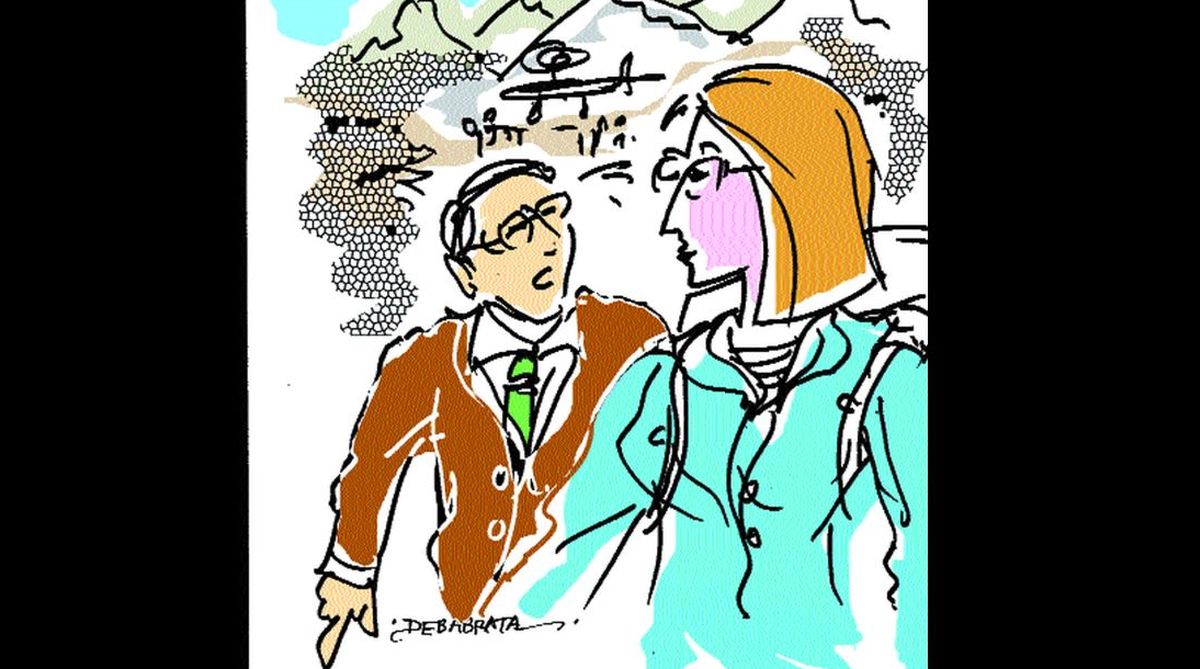Nepal, Qatar agree to increase cooperation in various sectors
The governments of Nepal and Qatar on Wednesday reached agreements on bilateral cooperation in various sectors.

Illustration: Debabrata Chakraborti
Brenda Wright was a well-known cardiac surgeon in Chicago. I met her only once and very briefly. What she said, however, remains seared in my memory.
Three days earlier, a large avalanche had come down the Annapurna circuit of the Himalayas and killed a seven-person team of Japanese mountaineers. The story broke on Tokyo television and was quickly picked up and broadcast by networks in Europe and the US.
It was the height of the tourist season in Kathmandu and there were hundreds of American tourists on the Everest and Annapurna tracks. Panicky families in the US started calling the US Embassy in Nepal, asking for news of friends and relations. As the consul it was my responsibility to help them.
Advertisement
Quickly I packed a bag, hopped onto a helicopter and rose 11,000 feet on the Himalayan range. The sudden change of altitude gave me a painful headache, but there was time to do no more than swallow a few pills. There was a lot to be done.
First, urge all the hikers at the height and the hikers coming down from greater heights to talk to their families, by now besotted by anxiety. For the American hikers, take down their names and those of their relatives, so that the families could be reassured. If I had a message of concern from the relatives already, talk to the hikers or arrange with the Embassy to send the relatives a reassuring word.
Next, arrange with the police and other government authorities to make sure that hikers from the US receive assistance in coming down to safe areas and, if injured, get special help. Also, contact non-government organisations, mountaineering associations and medical groups, so that ailing hikers are quickly brought to safe zones.
I visited the locations where helicopters were ferrying hikers from dangerous spots every hour and also all the inns and taverns where the incoming hikers were taking refuge. There were small hotels and ordinary homes that did informal business and housed hikers.
It was important to gather information on all American hikers and focus on the people reported missing by their families, other hikers or trekking organisations. Groups that had climbed together had become split in adverse weather and were anxious to know that individual members were alive and well.
After days of unremitting work, I had the results we were looking for. I had traced all missing persons except 17 hikers, and I had sufficient information about the movements of nearly a dozen of them to feel reasonably certain that they were safe. A group of five that had gone to 15,000 feet was expected to come down that evening, according to reports the police had received.
I came back to my hotel, had some dinner and around midnight ventured out in the hope of meeting the returning group of five.
It was around 3 a.m. that a watchman came to tell me that the group was tottering in. Yes, there were five in the group and three Sherpas. One mountaineer was sick and had delayed their reluctant descent. Four were relatively young, overly enthusiastic, and rued that adverse nature and cautious bureaucrats had ruined their adventure.
As the fifth member of the party shed heavy mountain gear, what emerged was a woman in her late thirties, with metal-frame glasses and shoulder-length hair, wearing a well-worn blue-green sports outfit. She identified herself as Brenda Wright. She practiced surgery in a well-known hospital group in Chicago and had visited Nepal six times, thrice as a tourist and then thrice as a mountaineer.
Her team had been very close to where the avalanche struck and had been saved by the foresight of an old Sherpa guide who had presciently judged the avalanche a grave threat and suggested a swift evacuation.
“Brenda, you realize, don’t you,” I asked, in the hearing of her team mates who seemed miffed at the sudden cancellation of their plan, “that you were in serious danger. It could have easily cost your life.”
“Yes, I do realize that,” she said, without a moment’s hesitation, “I know the danger was real and close. I am glad that we got out in time.”
“Tell me, what makes you keep coming back to Nepal? To the mountains?”
She smiled. “It is hard to explain,” she said. “At first it was just fun and adventure. Then it became something different. It became an event – an event that tests me and, in a peculiar way, restores me. I long to come back here and go up the mountain.”
I asked, “So you think you will come again, even after this brush with death?”
Brenda looked straight at me, “Believe me, I work eleven months at the hospital, always dreaming of the month I will spend on the mountains. It is constantly on my mind. I don’t know why, for I like my work and my patients. There is something in life beyond a comfortable existence and enjoyable work.”
She gave a pause and added, “I don’t know what that something is. But when I am up there, slogging through ice and snow with a load on my back, with people I barely know and share little in common, I breathe thin air and feel my heart work differently. I seem to sense a different aspect of life I haven’t quite understood. I hope I understand it one day.”
I held her now glove-less hand and said goodbye. As I trudged back to my hotel in bone-chilling air, I mulled over the aspects of life I had seen and the aspects I had missed.
The writer is a Washington-based international development advisor and had worked with the World Bank. He can be reached at mnandy@gmail.com
Advertisement